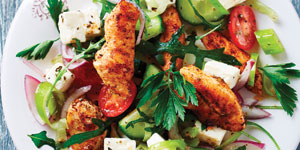
Question
I’ve heard of the concept of filling half your plate with fruits and vegetables. Does this also hold true for children? If so, I do have some concerns about food costs and the time involved in their preparation. Do you have any tips about these issues?
Answer
Yes, filling half your plate with fruits and vegetables is definitely a healthy way to go for the whole family – except for infants whose nutritional needs are different.
Eating more produce packed with nutrients and assorted health-promoting compounds offers a variety of perks including easier weight management and a decreased likelihood of developing many chronic diseases. Yet Canadians fall short on meeting the recommended number of servings of these foods on a daily basis. As a result, the Canadian Produce Marketing Association, the Heart and Stroke Foundation, the Canadian Public Health Association and the Canadian Cancer Society have teamed up to improve fruit and veggie consumption in Canada through an initiative called Half Your Plate at halfyourplate.ca. Check it out as it’s got plenty of helpful resources for you including recipes and videos.
A redesign of your family’s dinner plate can help put you on the right track. But you’re not alone if you feel there are barriers to boosting your family’s intake. Cost, availability and time for preparation are common concerns but they need not stand in the way.
Here are some tips to incorporate more of these nutritious eats into meals:
- To reduce costs, buy in season as some fruits and vegetables are cheaper when they are in season. But as we live in Canada where the growing season is short, consider frozen, canned and dried produce to keep prices down. In addition, use a shopping list and compare flyers to plan your menu. Then buy more when they’re on special and then prepare them in a dish that can be frozen.
- Frozen and canned fruits and vegetables are not just convenient, but are also often cheaper. They can sometimes be more nutritious than fresh as they are processed at the peak of their nutritional quality. Be sure to skip the ones with sauces and added ingredients such as salt.
- When buying canned vegetables, look for those low in salt or rinse them well before using. Canned fruits are convenient and can be a cost saving choice, but choose those canned in juice rather than in sugar.
- Look for time-saving products in the produce aisle. At the recent Canadian Produce Marketing Association Convention in Toronto, there were many brand-new convenience items on display that will soon be in supermarkets such spiralized zucchini and sweet potatoes along with all manner of chopped and ready-to-cook or eat produce. But don’t just use them in traditional ways. For example, instead of a side salad, you can add a chopped coleslaw mix to your vegetable soup for a quick preparation.
- Half your plate goes for all meals and snacks. Keeping a list of possibilities on the fridge can help make it happen more easily. Top cereal with some berries or banana, add some veggies to an omelette or have a sliced orange with breakfast. Munch on fruit or vegetable sticks with a yogurt or hummus dip at snack time and include vegetable toppings on sandwiches or marinate leftover vegetables from dinner for a quick lunch salad.
Originally published in ParentsCanada magazine, Fall 2017.



